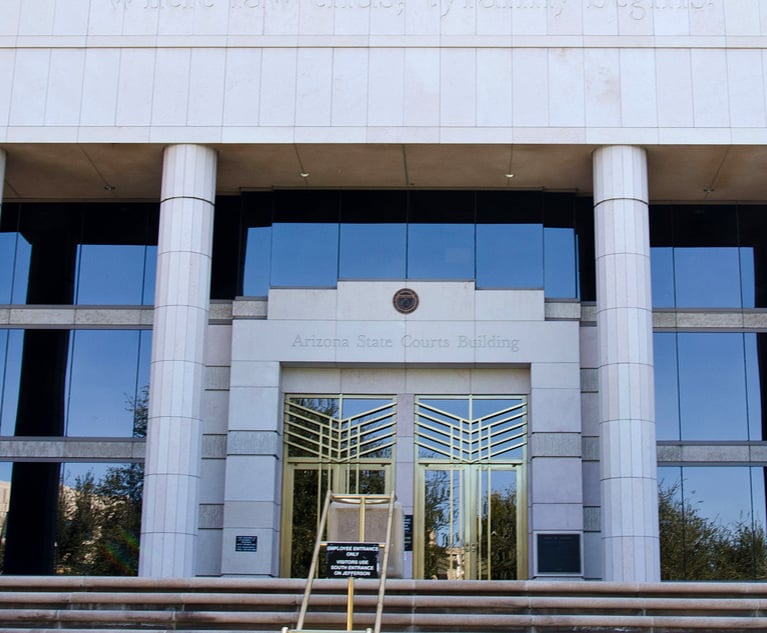Lies, damn lies and the gender pay gap statistics - what do the figures really tell us?
The pay gap reporting requirements have presented a unique PR challenge for law firms - so who came out best?
April 09, 2018 at 05:26 AM
6 minute read
The deadline has passed, the data is in and the dust has settled. But while the gender pay gap figures do offer some new insight into the make-up of the UK's largest law firms, does the data really tell us anything of value?
The new disclosure requirements have presented a unique challenge for law firms – how to dress up figures which, on the face of it, do not look good, while also preserving their credentials as progressive employers.
This has come with the added dilemma of whether to go the extra mile and include partners in the figures, with firms weighing up the PR win for selfless transparency against the negative headlines featuring much less flattering figures.
But despite appeals from a clutch of firms for industry-wide transparency, less than a third of the UK top 50 included any information about partner pay, and just seven gave a combined pay gap figure for all partners and employees.
This lack of consistency – combined with firms cherry-picking various fee-earner groups to present the smallest possible pay gaps for discrete groups – means many questions remain about what meaningful conclusions can be drawn from the figures.
Almost all firms took great pains to explain that the pay gap is an entirely different issue to equal pay, and that their figures were skewed by large numbers of women in support roles. But these points should be self-evident.
One thing the data has provided is concrete proof of the scale of female overrepresentation in lesser-paid roles, with women on average making up about 75% of the lowest-paid quartile at UK top 50 firms.
Only two UK top 50 firms – Travers Smith and Freshfields Bruckhaus Deringer – have less than 66.6% women in their lowest-paid quartile, while five have more than 80% – CMS (83%), Simmons & Simmons (83%), Kennedys (82%), CC (81.5%) and Ashurst (81%).
This imbalance is likely to shift as new technology enables more firms to scale back their secretarial ranks and more men take up flexi-working and parental leave, but the size of the task is highlighted by the fact that even without partners, the UK top 50 average median pay gap of 29% is almost three times that of the overall median for UK companies of 9.7%.
Law firms are more than keen to tout their countless diversity initiatives (which the pay gap reports gave them the opportunity to do, at great length) but the question now is whether they can prove that these efforts are making a tangible difference.
While this first round of figures has provided some interesting findings, some of which are listed below, the real conclusions will come next year when the next round of figures show us which firms are making the most progress towards gender pay parity.
What the figures tell us
Pay gaps
- The average pay gap for the UK top 50 law firms is 20.5% (mean) and 29% (median) – significantly higher than the 9.7% median pay gap for all UK companies, even without the inclusion of partners.
- Fifteen of the UK top 50 included partners in their reporting – Clifford Chance (CC), Linklaters, Hogan Lovells, Norton Rose Fulbright, Eversheds Sutherland, Pinsent Masons, Osborne Clarke (OC), Withers, Holman Fenwick Willan (HFW), RPC, Trowers & Hamlins, Weightmans, Mills & Reeve, Irwin Mitchell and Ince & Co.
- However, only seven of those firms – CC, OC, Linklaters, Pinsents, Norton Rose Fulbright, Gateley and RPC – provided a combined pay gap figure for partners and employees, and among this group, a variety of different calculation methods were used, making a meaningful comparison difficult.
- The UK top 50 firm with the smallest mean pay gap is Irwin Mitchell (12.8%), while the firm with the largest mean pay gap is Womble Bond Dickinson (29.3%).
- The UK top 50 firm with the smallest median pay gap is DLA Piper (12.2%), while the firm with the largest median pay gap is Ince & Co (42%).
Bonus gaps
- The UK top 50 firm with the smallest mean bonus gap is Kennedys (13.9%), while the firm with the largest mean bonus gap is Hill Dickinson (69.3%).
- Four UK top 50 firms have zero bonus pay gap on a median basis – Kennedys, Shoosmiths, Fieldfisher and DLA Piper, while Gateley has a median bonus pay gap of 32.4% in favour of women. The firm with the largest median gender bonus gap is Travers Smith (78.4%).
- Seven UK top 50 firms pay bonuses to more than 90% of their staff, with Mills & Reeve top for both men (97.3%) and women (94.9%), followed by Watson Farley & Williams, Macfarlanes, Trowers, HFW, Slaughters and Shoosmiths.
- Two UK top 50 law firms pay bonuses to less than 15% of both men and women – TLT and Weightmans – while Berwin Leighton Paisner (BLP) pays bonuses to just 11.5% of women.
- The firms with the biggest disparities in bonuses for men and women are Stewarts Law, where 84.3% of men receive a payout compared to 62.9% of women; BLP, where 30.3% of men get a bonus compared to just 11.5% of women; and Womble Bond Dickinson, where 34% of men and 23% of women receive a bonus.
US and international firms
- Twelve US and international firms with more than 250 UK employees reported their gender pay gaps – White & Case, Reed Smith, Baker McKenzie, Kirkland & Ellis, Dentons, Weil Gotshal & Manges, Mayer Brown, Squire Patton Boggs, Latham & Watkins, Dechert, Shearman & Sterling and Jones Day.
- Latham has the largest mean gender pay gap of those firms and all of the UK top 50 (39.1%), while Kirkland has the largest median gap (68.2%).
- The average mean and median pay gaps for non-UK firms (28.2% and 38.3%) are significantly wider than the equivalent figures for the UK top 50 (20.5% and 29%).
- Six US firms – Latham, Weil, Shearman, Dechert, Kirkland and Jones Day – have wider pay gaps than any of the UK top 50.
- Jones Day was the only law firm to report which does not pay a bonus to any of its staff.
This content has been archived. It is available through our partners, LexisNexis® and Bloomberg Law.
To view this content, please continue to their sites.
Not a Lexis Subscriber?
Subscribe Now
Not a Bloomberg Law Subscriber?
Subscribe Now
NOT FOR REPRINT
© 2025 ALM Global, LLC, All Rights Reserved. Request academic re-use from www.copyright.com. All other uses, submit a request to [email protected]. For more information visit Asset & Logo Licensing.
You Might Like
View All
KPMG's Bid To Practice Law in US On Hold As Arizona Court Exercises Caution

Law Firms 'Struggling' With Partner Pay Segmentation, as Top Rainmakers Bring In More Revenue
5 minute read
Trending Stories
- 1Law Firms Expand Scope of Immigration Expertise, Amid Blitz of Trump Orders
- 2Latest Boutique Combination in Florida Continues Am Law 200 Merger Activity
- 3Sarno da Costa D’Aniello Maceri LLC Announces Addition of New Office in Eatontown, NJ, and Named Partner
- 4Friday Newspaper
- 5Public Notices/Calendars
Who Got The Work
J. Brugh Lower of Gibbons has entered an appearance for industrial equipment supplier Devco Corporation in a pending trademark infringement lawsuit. The suit, accusing the defendant of selling knock-off Graco products, was filed Dec. 18 in New Jersey District Court by Rivkin Radler on behalf of Graco Inc. and Graco Minnesota. The case, assigned to U.S. District Judge Zahid N. Quraishi, is 3:24-cv-11294, Graco Inc. et al v. Devco Corporation.
Who Got The Work
Rebecca Maller-Stein and Kent A. Yalowitz of Arnold & Porter Kaye Scholer have entered their appearances for Hanaco Venture Capital and its executives, Lior Prosor and David Frankel, in a pending securities lawsuit. The action, filed on Dec. 24 in New York Southern District Court by Zell, Aron & Co. on behalf of Goldeneye Advisors, accuses the defendants of negligently and fraudulently managing the plaintiff's $1 million investment. The case, assigned to U.S. District Judge Vernon S. Broderick, is 1:24-cv-09918, Goldeneye Advisors, LLC v. Hanaco Venture Capital, Ltd. et al.
Who Got The Work
Attorneys from A&O Shearman has stepped in as defense counsel for Toronto-Dominion Bank and other defendants in a pending securities class action. The suit, filed Dec. 11 in New York Southern District Court by Bleichmar Fonti & Auld, accuses the defendants of concealing the bank's 'pervasive' deficiencies in regards to its compliance with the Bank Secrecy Act and the quality of its anti-money laundering controls. The case, assigned to U.S. District Judge Arun Subramanian, is 1:24-cv-09445, Gonzalez v. The Toronto-Dominion Bank et al.
Who Got The Work
Crown Castle International, a Pennsylvania company providing shared communications infrastructure, has turned to Luke D. Wolf of Gordon Rees Scully Mansukhani to fend off a pending breach-of-contract lawsuit. The court action, filed Nov. 25 in Michigan Eastern District Court by Hooper Hathaway PC on behalf of The Town Residences LLC, accuses Crown Castle of failing to transfer approximately $30,000 in utility payments from T-Mobile in breach of a roof-top lease and assignment agreement. The case, assigned to U.S. District Judge Susan K. Declercq, is 2:24-cv-13131, The Town Residences LLC v. T-Mobile US, Inc. et al.
Who Got The Work
Wilfred P. Coronato and Daniel M. Schwartz of McCarter & English have stepped in as defense counsel to Electrolux Home Products Inc. in a pending product liability lawsuit. The court action, filed Nov. 26 in New York Eastern District Court by Poulos Lopiccolo PC and Nagel Rice LLP on behalf of David Stern, alleges that the defendant's refrigerators’ drawers and shelving repeatedly break and fall apart within months after purchase. The case, assigned to U.S. District Judge Joan M. Azrack, is 2:24-cv-08204, Stern v. Electrolux Home Products, Inc.
Featured Firms
Law Offices of Gary Martin Hays & Associates, P.C.
(470) 294-1674
Law Offices of Mark E. Salomone
(857) 444-6468
Smith & Hassler
(713) 739-1250










